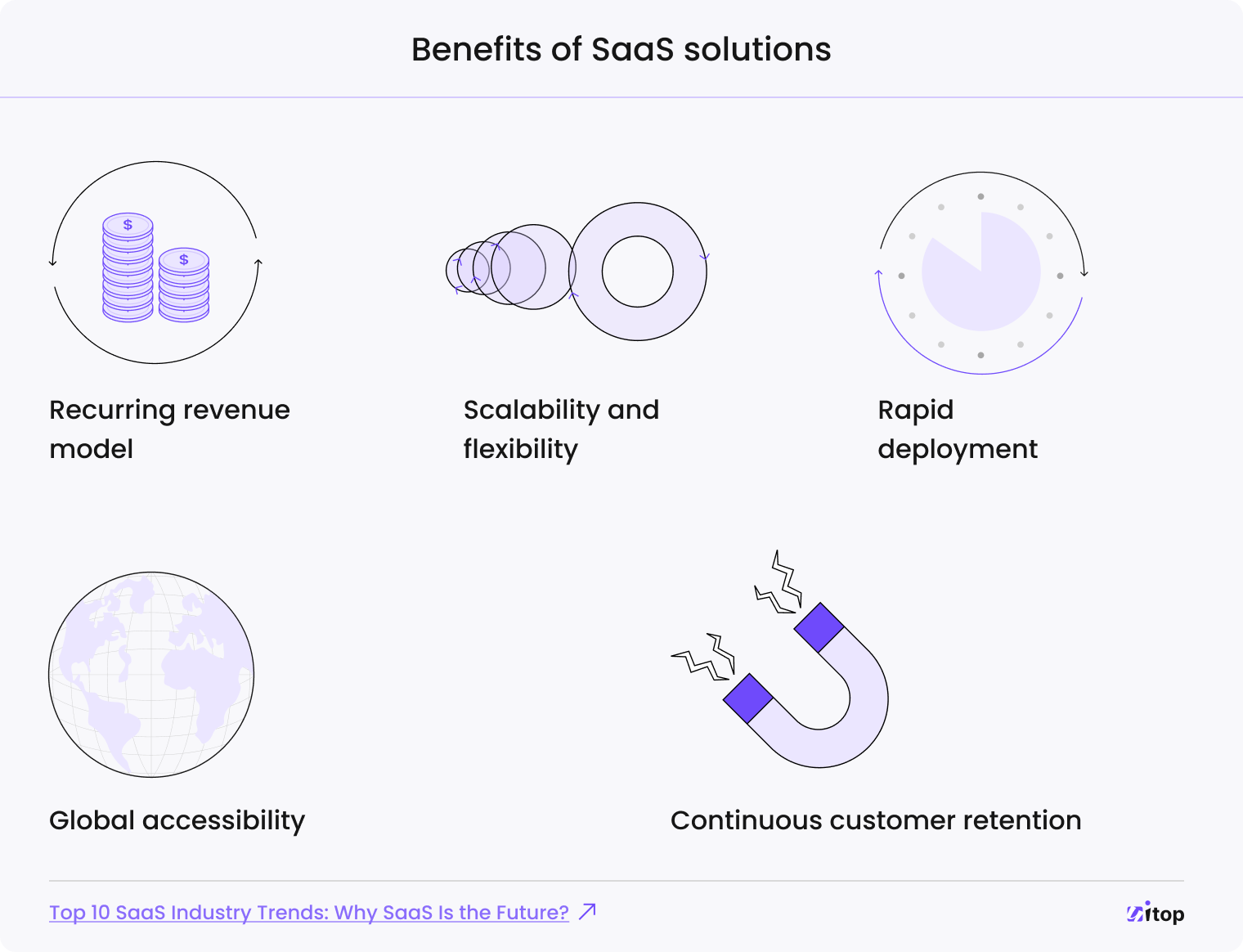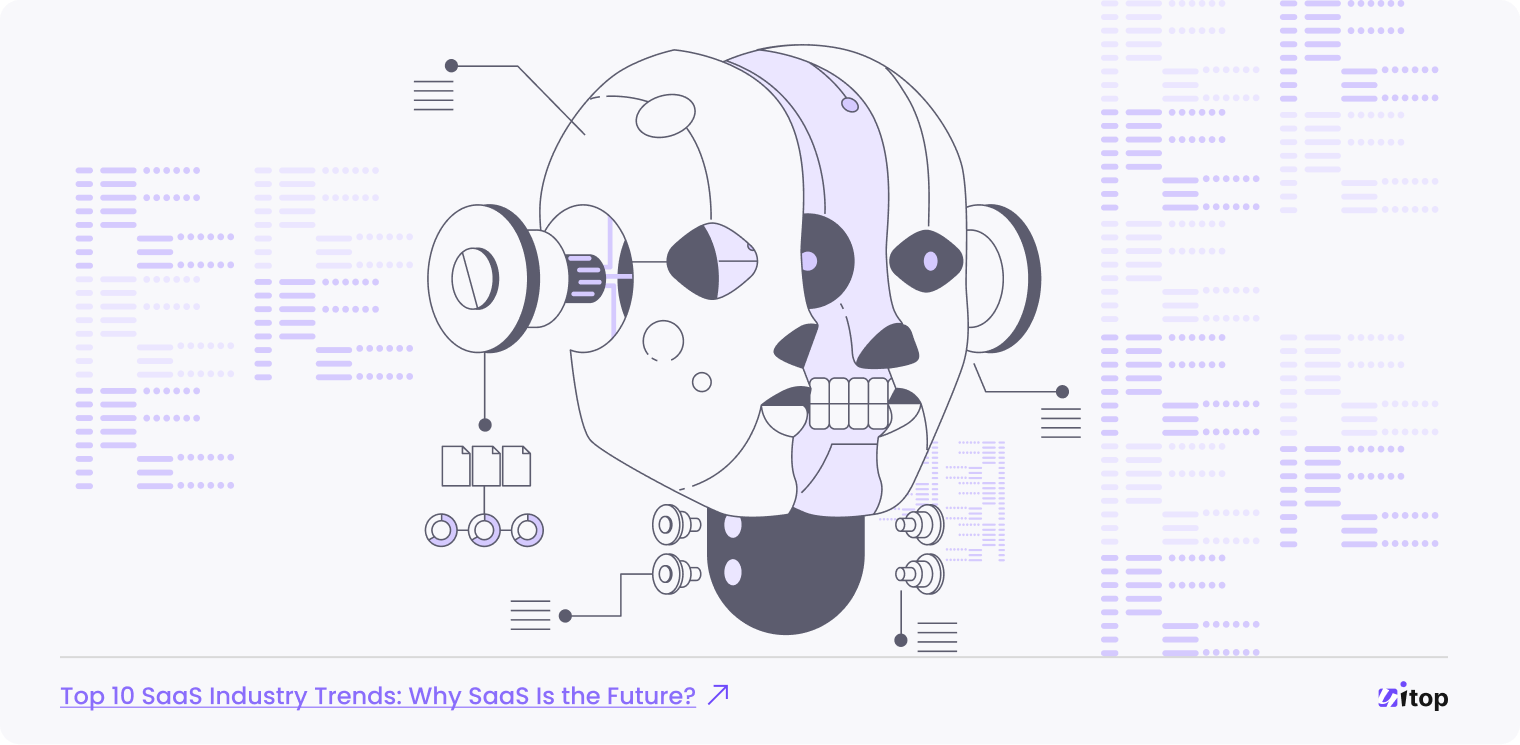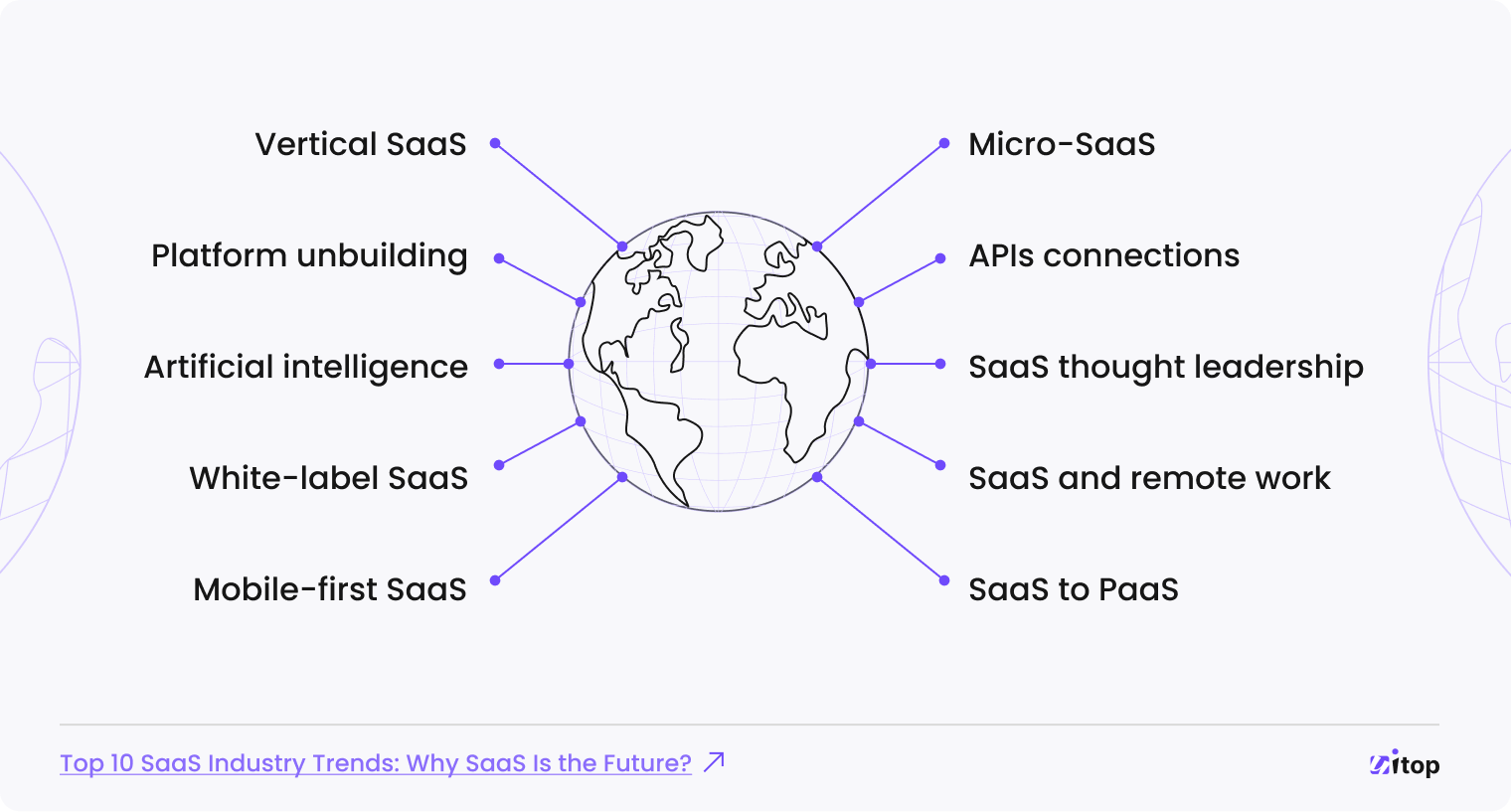What is SaaS?
If you're just beginning to research the idea of SaaS, this is the place to understand what SaaS can accomplish for you, how it works and differs, what are the main examples and what the future holds for SaaS development.
The SaaS industry is experiencing unprecedented growth and rapid expansion. As an innovative business model, it offers users enhanced accessibility to software applications without any expensive upfront costs or traditional installation cycles. This makes it a desirable solution that is transforming the way businesses approach their technology investments.
So it’s no wonder that more businesses are switching to SaaS platforms every day— it can be profoundly beneficial for companies of all sizes.
But what is propelling such remarkable growth in the SaaS industry? In this article, we’ll uncover the top 10 software as a service trends and discuss why they suggest a future with SaaS is inevitable.
In recent years, SaaS solutions have skyrocketed in popularity thanks to the multitude of advantages they offer. From scalability and cost-efficiency to 24/7 availability and reduced maintenance needs, there are countless benefits that make choosing a SaaS solution an absolute no-brainer. Let’s take a closer look at them:

SaaS is gaining immense popularity owing to its numerous benefits. In this context, let’s explore the emerging trends that are likely to influence the future of SaaS and sustain the growth of cloud computing.

Artificial intelligence (AI) and machine learning (ML) have been taking the SaaS world by storm lately. Companies are using these algorithms to boost their efficiency, accuracy, and personalization, paving the way for a revolutionary era of progress in the industry.
AI and ML-powered SaaS solutions can analyze user data, adapt the platform accordingly, and streamline workflows while helping you keep those valuable customer relationships going strong.
With AI-driven SaaS analytics and advanced ML algorithms, businesses now have powerful tools to make sense of massive datasets. Harnessing the insights from these large data sets helps organizations uncover trends and develop more effective strategies for performance improvement.
Moreover, their capabilities enable businesses to handle time-consuming tasks such as data entry, customer support duties, and analytics quickly and with minimal effort. This allows companies to save resources and accomplish more in less time! Additionally, since a tech-savvy machine handles most of the work, there is no need to worry about human errors.
Not to mention that AI and ML tech can enhance SaaS security. ML algorithms are especially helpful, crunching through tons of data quickly to detect threats fast, giving your platform some serious extra protection.
Platform unbuilding is another trend revolutionizing how we use SaaS, making it easier and more efficient to craft custom solutions that cater perfectly to individual business needs. Companies can mix and match components by breaking up complex systems into small modules for unprecedented customization and scalability.
The ability to quickly add and remove components means your solutions can seamlessly fit in with other software tools, creating a perfect-fit technology environment that helps you keep up with advancing innovation.
By honing in on developing single components, you can streamline the rollout of updates and features. That way, you won’t get left behind, as you’ll have access to fresh tech advancements swiftly!
Vertical SaaS provides an innovative way of delivering software that is tailored to the particular needs and demands of a specific industry. Unlike horizontal SaaS solutions, which provide universal coverage across multiple areas, vertical SaaS focuses on providing specialized services for niche markets, offering creative ways to confront the unique challenges companies face within these industries.
So recently, businesses have jumped on the bandwagon of vertical software development to gain an upper hand over their rivals. By leveraging specialized solutions tailored specifically for them, they can maximize efficiency and stay ahead of the game. With less customization and configuration needed during the implementation stage, you can quickly adopt this type of software and experience its great benefits in no time.
In addition, vertical SaaS companies use their special industry knowledge to develop sophisticated software that follows all the official regulations and requirements. This not only ensures businesses stay within legal boundaries but also keeps them safe from any potential fines or penalties associated with non-compliance.
Businesses looking to expand their offerings and reach new markets quickly have followed the white-labeling SaaS trend. This modern solution allows companies to customize third-party software with a personal touch by rebranding it as their own product without investing in costly in-house development.
For businesses looking to capitalize on market opportunities and quickly meet customer demands, white-labeling SaaS solutions provide a great way forward. By utilizing pre-built, customizable platforms, they can drastically reduce development time and resources, launching new software products much faster.
In this way, companies can leverage white-label SaaS solutions to open up unexplored markets, target specific audiences, and generate new income streams, thereby speeding up their expansion process and setting themselves on the path to long-term success.

As mobile technology continues to become intertwined with everyday life, the demand for SaaS solutions that prioritize user experience and functionality on mobile devices is growing. By taking advantage of this trend towards mobile-first SaaS development, modern users are able to access applications and services seamlessly, no matter where they go!
So as the number of mobile users continues to increase around the world, software providers have an incredible opportunity to tap into this vast potential market. By delivering a hassle-free experience on their mobile SaaS platforms, companies can both draw in new customers and retain current ones.
In addition, by utilizing the exclusive features of mobile devices, from location services to biometric authentication, SaaS providers can create a unique and enjoyable experience for users tailored precisely to their needs.
Businesses are recognizing the value of tailored software, and micro-SaaS products have become a popular way to fill gaps in larger SaaS platforms. Micro SaaS, in simple terms, is a tiny, super-focused software service that caters to a specific need or niche market, often working as an add-on to a larger software system.This trend is providing entrepreneurs with avenues for capitalizing on specialized market needs.
Micro-SaaS products are a great way for entrepreneurs and startups to break into the software market without breaking the bank. With minimal upfront investment, they can avoid costly overhead while still accessing powerful SaaS solutions.
A micro-SaaS product is also the perfect size for those looking to stay ahead of the ever-evolving software market. Easily adjustable, these products allow companies to remain at the peak of their industry’s trend cycle with continuous improvements and updates.
What’s more, by joining forces, micro-SaaS solutions and larger SaaS platforms create a SaaS landscape of connected software products. This collaboration offers multiple advantages, from elevated user satisfaction to heightened engagement, ultimately providing a holistically enhanced experience for everyone involved.
As technology marches on, businesses are seizing the opportunity to move beyond merely using ready-to-use software solutions. By adopting the SaaS-to-PaaS trend, companies can enjoy the best of both worlds—leveraging preconfigured applications and developing custom programs hosted within existing ecosystems. This shift offers greater flexibility in data management and improved control over deployments at both infrastructure and application levels.
Combining these capabilities allows businesses to create custom applications efficiently without needing multiple tools and resources. The SaaS-to-PaaS trend streamlines developing, deploying, and reaping the benefits of generalized and tailor-made software solutions.
The transition from SaaS to PaaS also presents an exciting chance for businesses to access a treasure trove of existing components and tools. Collaborating across different sectors, companies can develop cutting-edge solutions that fuel growth within their industry, connecting the dots between various aspects of software development and deployment in a cohesive and innovative manner.
In the SaaS industry, seamless integration between multiple software platforms is becoming increasingly important. APIs provide a framework for efficient data exchange and communication that make SaaS solutions more connected, flexible, and scalable to meet diverse business needs, improving productivity and user experience overall.
API connections streamline the process of keeping users up-to-date with the latest and most reliable information. Businesses can now bid farewell to concerns about outdated data leading them astray, trusting that their decisions are backed by real-time intelligence. This paves the way for smarter strategies and better overall results.
Leveraging the power of APIs, companies can unlock the potential of custom-made tech solutions—an ingenious approach to connecting various SaaS platforms and crafting tailor-made software ecosystems that precisely fit their needs. This newfound freedom in creating technology infrastructure enables organizations to accelerate toward their goals like never before.
In the ever-competitive SaaS industry, thought leadership is a strategy to help companies rise above. By providing customers with insights and trends from their sector’s experts, software providers can build trust in themselves as innovative leaders that will take clients further on their journey to success. It has become increasingly important for such firms to invest in this approach if they want to establish loyalty and create lasting growth.
Demonstrating a commitment to customer success and industry growth through thought leadership initiatives is an effective way for SaaS companies to gain trust from their current customers as well as attract new ones. This includes providing useful information, participating in events, and giving expert insights on social media.
Through thought leadership, SaaS companies can also make their mark in a competitive world by showing off their unique know-how and ideas. This offers an edge customers look for when selecting providers — they want to feel confident the company truly grasps what it takes to succeed in today’s industry climate.
The rise of remote work SaaS is another perfect opportunity for SaaS solutions to take center stage. By offering cloud-based access and reliable user experience, SaaS applications have become critical components in making sure that distributed teams can collaborate easily, stay connected seamlessly, and maintain productivity no matter where they are located.
SaaS solutions empower remote employees to carry their office with them, ensuring teams stay connected and productive from any location. This makes collaboration a breeze, even when team members are miles apart.
By embracing SaaS, teams can streamline their communication and collaboration efforts in one platform. Gone are the days of juggling multiple tools for chatting, video conferencing, and file-sharing. This integrated approach boosts efficiency, enhances productivity, and fosters collaboration among remote teams.
For businesses with distributed teams, SaaS solutions offer an ideal cost-management strategy. Subscription-based pricing allows companies to pay only for the features and users they need, eliminating the necessity for investments in costly hardware or infrastructure.
SaaS is here to stay and become increasingly embedded into our daily lives. As technology continues to evolve and change, SaaS will follow suit, adapting to meet user demands at an unprecedented rate. Better yet, SaaS solutions are becoming more affordable and accessible daily, further adding to their appeal.
All of these trends in SaaS point towards an even brighter future of SaaS industry and those who take advantage of this powerful service model. It’s no wonder why many forecasts predict that SaaS will be the predominant form of data exchange for organizations in the upcoming years.
With so many advantages associated with SaaS implementations, it’s simply a matter of when rather than if it becomes ubiquitous in business operations on a global scale. So let’s get ahead of the competition and start embracing SaaS before everyone else!

The top 10 SaaS industry trends include:
AI and machine learning have revolutionized SaaS solutions, making them an increasingly invaluable part of any business. Automating tedious tasks helps streamline workflows while offering personalization that makes customers feel heard. Additionally, it allows companies to make more informed decisions with better analytics and insights at their fingertips, ultimately providing cost savings without compromising on quality or speed.
Specialized software solutions tailored to the specific needs and goals of niche industries, known as vertical SaaS products, have become increasingly popular in recent years. By providing targeted solutions designed specifically for certain markets or segments of customers, businesses can realize a higher return on investment while achieving better outcomes than they would with generic software offerings.
Subscription-based pricing models are powering the rapid growth of SaaS. By providing a flexible, affordable, and tailor-made approach to usage charges, customers can get access to the features they need without being locked into long-term contracts or spending more than necessary, making it easier for small and medium businesses to get on board with industry-leading solutions.
If you're just beginning to research the idea of SaaS, this is the place to understand what SaaS can accomplish for you, how it works and differs, what are the main examples and what the future holds for SaaS development.
In today’s rapidly advancing SaaS industry, UX/UI design has become an indispensable aspect of a product’s success. User onboarding stands at the forefront of UX, serving as a user’s first contact with a product and laying the groundwork for their experience. In this thought-provoking article, we explore the importance of SaaS onboarding and its impact […]
The advent of software-as-a-service (SaaS) solutions has ushered in a new era in technology and business. Gone are the days of complicated installations, high licensing fees, and all the headaches that come with them. SaaS represents a paradigm shift away from traditional, time-consuming, and costly methods of software delivery to a more flexible, cost-effective, and […]
“They took extra time to ensure that our frontend developer could easily implement the wireframes.”


Our processes with your needs in mind drives any SaaS product growth. Let’s see how our approach aligns with your vision.
Let’s discuss your design challenges
Please leave your email so we can contact you

Tell us a little more about your product so we can estimate it
We'll help you make the right choice!
Leave your email to receive regular updates to your inbox